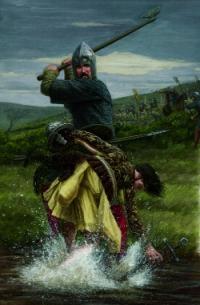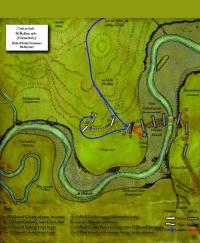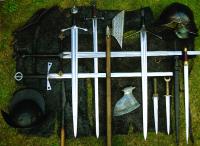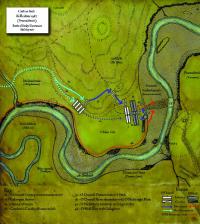The battle of the Swilly (Farsetmore), 8 May 1567
Published in Early Modern History (1500–1700), Features, Issue 3 (May/June 2011), Volume 19
An artist’s impression of an O’Donnell gallowglass dispatching an O’Neill kern in the waters of the Swilly, with Glebe Hill in the background, 8 May 1567. (Seán Ó Brógáin)
The Swilly estuary’s physical dynamic, coupled with its terrain characteristics and tidal water, creates a formidable tactical and strategic obstacle. This would be an important but underestimated element of O’Donnell’s victory. On entering O’Donnell’s territory, O’Neill had to cross this imposing physical barrier. Once across, his advancing army encountered steep hills to its front and the Swilly waters to the rear and flanks, preventing any chance of a rapid extraction if his incursion failed. Success in this dangerous exploit necessitated a fast, effective initial thrust into Tír Chonaill. Failure would leave O’Neill at the mercy of the tidal water and an irascible enemy fighting on his own territory. On receiving advance warning of O’Neill’s impending incursion (7 May), O’Donnell issued a call to arms or éirí amach: ‘The place where O’Donnell happened to be with a few forces at this time, with Hugh Oge, the son of Hugh Roe, and with others of his relations, was Ard-an-ghaire [Ardagarry], on the north side of the estuary which is called Suileach [Swilly]; and, hearing that O’Neill had arrived with his forces in the country, he dispatched messengers to summon such of his chieftains as were in his neighbourhood, and he himself awaited them there at Ard-an-ghaire; they did not, however, come fully assembled at his summons.’
O’Donnell waits and observes
O’Donnell’s lack of activity on the 7th can be explained by a simple need to establish O’Neill’s primary objective—Scarrifsholis (Sgairbh-Sholais), 4km west of Letterkenny, or the great tidal ford of Farsetmore (Fearsaid Súileach). His enemies’ approach from Raphoe via Mongorry Hill, Glenmaquin, Listillion and Dromore Hill made it necessary for O’Donnell to stand fast and observe from his position at Ardagarry, 2.5km north-north-east of the battlefield. Its unparalleled panoramic view provided him with a strategically important position from which to observe all approaches to the Swilly, thereby allowing him to make appropriate preparations as needed. For Shane O’Neill, advancing on Farsetmore entailed crossing to Porterfield, then (in 1567) surrounded by a tidal marsh. This constraint would not have been lost on O’Donnell. Shane’s cavalry, infantry and supply train would all have been strung out while traversing this slow, difficult terrain, but once he reached the ford it had to be crossed quickly during low tide, as time was his first enemy. Screening his impending crossing, Shane committed his vanguard. O’Donnell probably anticipated his adversary’s strategy once he was committed to the crossing. While appreciating Shane’s superior numbers, he also had to contend with dissension within his own camp, which must have given him cause for concern and caution. The Four Masters hint at O’Donnell’s reluctance to join battle, possibly misunderstanding the military nuances and attributing tactical withdrawal to fear. This could well have been part of O’Donnell’s overall strategy: careful use of terrain and an unwillingness to expose his limited force to possible destruction. At this stage O’Donnell had probably advanced from Ardagarry, but a pre-emptive attack would give O’Neill the option to retreat, drawing O’Donnell’s numerically inferior force to a location of his choosing. Consequently, O’Neill’s inability to amass troops quickly on the north bank of the Swilly would prove fatal. It is conceivable, therefore, that O’Neill may not have fully appreciated O’Donnell’s tenuous capabilities.

O’Neill crosses the Fearsaid to establish a bridgehead on the north bank of the Swilly; O’Donnell engages him initially, securing his position by checking any further infiltration into Tír Chonaill, and then awaits his anticipated reinforcements. (Tomás Ó Brógáin/Galóg Chata)
First map
O’Donnell needed to position himself to avoid encirclement, so he quickly deployed his cavalry against O’Neill’s spearhead (1a, A). This in turn allowed him to secure the strategically important Magherennan gap with his small infantry force (1b, 2a), using the ensuing cavalry engagement (B) as a mask, although the Four Masters seem to claim that Hugh exited the field with his infantry before he should. The subsequent disengagement of his cavalry would suggest that it was tactical in nature to consolidate the high, narrow gap (2b). ‘When the son of O’Donnell (Hugh, the son of Hugh) perceived the numbers who were opposed to him, and that his lord had retired to a place of security, he followed him, in order to await the arrival of relief from his people.’ It was designed no doubt to play on O’Neill’s well-attested arrogance, highlighted by the fact that he subsequently pitched camp (C) immediately on crossing the Swilly (D). Now

Reproductions of some of the weapons and equipment used in the battle. After crossing the Swilly, O’Neill’s troops needed to re-deploy and re-equip themselves for battle, as the warriors’ apprentices would have carried much of their equipment separately, creating a significant delay in deployment. (Dave Swift, Claíomh)
surrounded by water, with hills and a hostile host blocking his only avenues of escape or advance, he was trapped. The constricted nature of the Cluain Áire in 1567 (half its present-day area) would hamper O’Neill’s operations. Without an open flank he was now in serious trouble, with an estimated 2,000–3,000 men in a substantial camp, including horses, on the plain. Even if he committed all his troops in one mass frontal assault his advantage would have been negated by the narrow nature of his only axis of advance. Thus Shane had forfeited all his advantages in one decisive moment, enabling O’Donnell to parry any tactical manoeuvre. O’Neill’s troops also needed to re-deploy and re-equip themselves for battle, as the warriors’ apprentices would have carried much of their equipment separately across the river, creating a significant delay in deployment. O’Donnell’s cavalry could now have harried O’Neill’s vulnerable troops at will, but for some reason they refrained, creating a false sense of security—and superiority—in O’Neill. O’Donnell now only needed to secure the narrow corridor at Magherennan, which provided an easily defensible location for infantry, well protected from encirclement by the slopes of the Glebe to the left/north.

O’Donnell’s reinforcements arrive, deepening his defensive position. After his address to the host, his phalanx advances on O’Neill’s camp. (Tomás Ó Brógáin/Galóg Chata)
Second map
At this critical juncture, O’Donnell’s reinforcements arrived (1a, 1b): ‘. . . when he [O’Donnell] perceived numbers of his faithful people advancing towards him, and rejoiced was he at their arrival. Thither came, in the first place, Mac Sweeny-na-dTuath (Murrough Mall, the son of Owen Oge, son of Owen); the sons of Mac Sweeny Fanad, Turlough Oge and Hugh Boy; and Mac Sweeny Banagh (Mulmurry, the son of Hugh, son of Niall). And when all had arrived at one place, they formed no very great force, for they were only four hundred in number.’ The 400 gallowglass referred to by the Four Masters excluded an unknown number of buanadha (bonnaghts) and ceitheirn tighe (native/household kern), which no doubt accompanied this war party. News of this relief force’s imminent arrival may also explain O’Donnell’s rapid tactical withdrawal to consolidate his remaining troops. The annalists suggest that O’Donnell gave a passionate speech at this point: ‘O’Donnell complained of his distress and injuries; and he protested to them that he would deem it more pleasing and becoming to fall and to die in the field, than to endure the contempt and dishonour with which he himself, his tribe, and his relations, had been treated by the Kinel-Owen, such as his ancestors had never suffered or endured before; but more especially the insult and indignity they had offered him on this occasion, by violently expelling and banishing him from his fortress.’ O’Donnell’s phalanx consisted mainly of gallowglass ‘battles’, which resolutely advanced towards their enemy (2a, 2b). O’Neill’s options now diminished, as man and nature conspired against him. He was unprepared for the ferocity of O’Donnell’s attack, but the annalists nevertheless convey his arrogance: ‘It is very wonderful and amazing to me that those people should not find it easier to make full concessions to us, and submit to our awards, than thus come forward to us to be immediately slaughtered and destroyed.’ As O’Donnell’s force attacked, it is conceivable that Shane ‘the Proud’ presumed that O’Donnell would tacitly advance and then seek terms. When O’Neill realised his mistake, he faced the full fury of O’Donnell’s host (3a, 3b). Turning the contest by surprise, speed and aggression, O’Donnell forced his foe to break and run (4a). Pursued to the river’s edge, a great slaughter ensued. O’Neill’s casualties are estimated at 1,300 (the English estimated 618), with no mention made of prisoners or hostages. O’Donnell’s casualties are not known. Many of those attempting escape drowned in the rising tide, which suggests the battle’s chronology, concluding within six hours of O’Neill’s initial crossing. After this defeat, Séan ‘a Díomas’ [Shane] ignominiously escaped along with his erstwhile companions the Gallaghers (4b). They skulked along the north bank of the Swilly, which they crossed on reaching Ath-Thairsi (‘Ford of Protection’) between Oldtown and Scarrifholis. Shane made it back to Tyrone no longer ‘puffed up like the devil’. Foolishly he then attempted to ingratiate himself with the McDonnells of Antrim, who dispatched him during negotiations at Cushendun on 2 June 1567. Much has been written about the age-old political rivalry between the O’Donnells and the O’Neills, but the significance of this pivotal battle has been overlooked: O’Donnell’s triumph was predicated on his guile and his clever use of terrain, rather than, as many have suggested, on mere chance. HI Tomás Ó Brógáin, a former member of the Irish defence forces reserve, is currently a student of Irish history and politics at the University of Ulster, Magee. Further reading: C. Brady, Shane O’Neill (Dublin, 1996). F. Cannon, Galloglass 1250–1600: Gaelic mercenary warrior (London, 2010). G.A. Hayes-McCoy, Irish battles: a military history of Ireland (Belfast, 1990). J. O’Donovan (trans.), Annals of the Four Masters (ed. E. Ryan) (Cork, 2008).
















